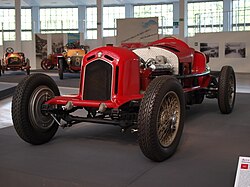Alfa Romeo Tipo A
| Constructor: | Vittorio Jano | ||||||||
| Predecessor: | Alfa Romeo P2 / P2-30 | ||||||||
| Successor: | Alfa Romeo Tipo B ("P3") | ||||||||
| Technical specifications | |||||||||
|---|---|---|---|---|---|---|---|---|---|
| Chassis: | conventional lead frame | ||||||||
| Engine: | Two 6-cylinder in-line engines with 1750 cm³ each |
||||||||
| Length: | 4100 mm | ||||||||
| Width: | 1590 mm | ||||||||
| Wheelbase: | 2800 mm | ||||||||
| Weight: | 930 kg | ||||||||
| Tires: | Pirelli | ||||||||
| Petrol: | petrol | ||||||||
| statistics | |||||||||
| Driver: |
|
||||||||
|
|||||||||
| World Cup points: | - | ||||||||
| Podiums: | - | ||||||||
| Leadership laps: | k. A. / tba | ||||||||
The Alfa Romeo Tipo A was a racing car produced by Alfa Romeo in 1931 . It was the first single-seater ( monoposto ) that the Milan-based automaker built. The car had two six-cylinder - inline engines each with 1,750 cc engine capacity . With an output of 230 hp (172 kW), the car reached a top speed of 240 km / h
background
Alfa Romeo had made its first attempt to compete in Grands Prix in 1923 with the Alfa Romeo P1 . The project failed for several reasons (including the death of Ugo Sivocci during training), so that Nicola Romeo had the car scrapped. The Grand Prix plans were pursued and the company designed the Alfa Romeo P2 . For this purpose, Vittorio Jano , whom the then Alfa Romeo works driver Enzo Ferrari had poached from Fiat , developed a compressor-loaded eight-cylinder engine with 1987 cc, which developed up to 103 kW (140 hp ) and allowed a top speed of 225 km / h . This engine proved to be very competitive and scored several Grand Prix victories. After changes in the statutes, the P2 was no longer compliant for a number of major races at the end of the 1926 season . The cars were not completely retired and won the Targa Florio 1930 . Jano turned his attention to the new road car 6C 1500 and after three seasons Alfa Romeo withdrew from Grand Prix races.
At the time, the sports association struggled to get participants to agree on the Grand Prix formula and failed again in 1931. So the races were once again held according to the rules of Formula Libre . This meant that the "small" Alfa Romeo with their 1987 cm² engines had to compete against the huge Mercedes-SSK (with a displacement of over 7 liters). Jano was not convinced that the 8C 2300 would be strong enough to face the much tougher competition on the high-speed lines and developed the unusual Tipo A. Together with the 8C 2300, it was ready in time for the season opener in Monza .
Development and technology
The most unusual feature of the Tipo A was its engine: two supercharged 6-cylinder engines with 1750 cm³ each, which were installed next to each other in an 8C chassis. Each engine was connected to a separate three-speed gearbox that transmitted the power to the rear wheels via its own differential. The driver sat on the two drive shafts in the middle of the car. With the light aluminum body, the Tipo A was Alfa Romeo's first single-seater or " monoposto ". The twelve cylinders together developed 230 hp and were sufficient to bring the 930 kg racing car to a top speed of 240 km / h.
This complex machine proved to be technically very fragile when it debuted in Monza. The Tipo A retired after only two hours of the ten-hour race in third position. In addition, the car was difficult to control (probably because of the weight of the two engines in the front area).
history
A total of three more cars were built, but this first “ bimotore ” experiment was unsuccessful for the entire season. Giuseppe Campari drove a Tipo A to win the Coppa Acerbo 1931 in Pescara , while Tazio Nuvolari came third. The car was largely replaced by the Tipo B or "P3" in 1932 , which was powered by a single 8C-2300 engine. The death of Luigi Arcangeli on the Monza circuit during tests for the 1931 Italian Grand Prix and the technical problems that still existed with the model prompted Alfa Romeo to finally end the project.
Technical information
| Alfa Romeo Tipo A | |
|---|---|
| engine | Two 6-cylinder in-line engines |
| Displacement | 2991 cm³ / 106.9 cu in |
| Bore × stroke | 65.0 mm × 88.0 mm |
| Compression ratio | 5.0: 1 |
| Power at 1 / min | 115 PS / 86 kW at 5200 rpm |
| Valve control | two overhead camshafts / 2 valves per cylinder |
| Mixture preparation | Memini DOA carburetor, compressor |
| cooling | water |
| transmission | 3-speed gearbox, not synchronized (rear-wheel drive) |
| Brakes | Drum brakes on all wheels |
| Front suspension | semi-elliptical leaf springs, friction dampers |
| Rear suspension | semi-elliptical transverse leaf springs, friction dampers |
| Body and frame | Aluminum body on a ladder frame |
| wheelbase | 2800 mm |
| Track width front / rear | 1380 mm / 1380 mm |
| Front tire size | unknown |
| Rear tire size | unknown |
| Dimensions L × W × H | 4100 mm × 1590 mm × - |
| Empty weight (without driver) | 930 kg |
| Tank capacity | unknown |
| Fuel consumption | unknown |
| Top speed | 240 km / h (149 mph) |
Whereabouts
None of the copies produced have survived. Brand expert Luigi Fusi was commissioned to reconstruct a replica especially for the Alfa Romeo 8C-35 Tipo C. His model is exhibited in the Museo storico Alfa Romeo in Arese .
literature
- Griffith Borgeson, (1990). The Alfa Romeo Tradition. City: Haynes (Foulis) Publishing Group Ltd. Somerset, UK. ISBN 0-85429-875-4 .
- David Owen, Grandi Marche - Alfa Romeo, Milano, Edizioni Acanthus, 1985.
Web links
- Ultimatecarpage.com Type A information. Accessed June 8, 2020
Individual evidence
- ↑ a b 1931 Alfa Romeo Tipo A Monoposto - Images, Specifications and Information. Accessed June 7, 2020 (English).
- ^ Centro Documentazione Alfa Romeo. Retrieved June 7, 2020 (Italian).
- ^ David Owen, Grandi Marche - Alfa Romeo, Milano, Edizioni Acanthus, 1985
- ↑ 1931 Alfa Romeo Tipo A Monoposto Specifications. Retrieved June 8, 2020 .
- ↑ 1934 Alfa Romeo Tipo B P3. Retrieved June 8, 2020 .

